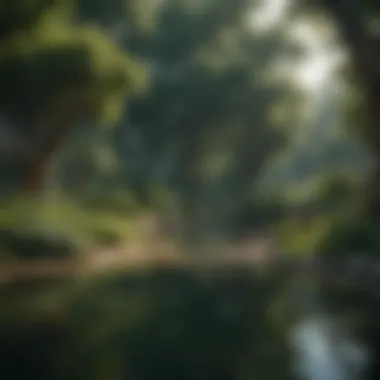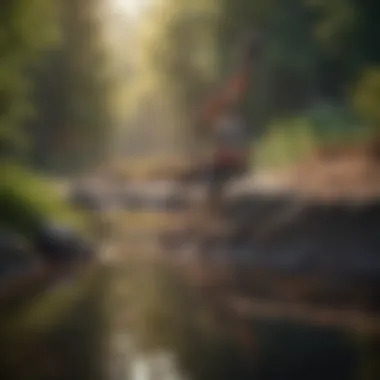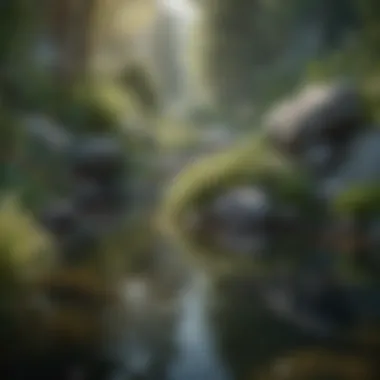Expert Tips for Creating Your Own Stunning Pond Oasis


Overview of the Topic
Creating a pond in your backyard can elevate your space into a tranquil oasis, creating a harmonious balance between nature and human presence. Ponds are not only aesthetically pleasing but also serve as a valuable ecosystem for various plants and animals, contributing to biodiversity within your property.
Current Status and Challenges
Currently, the construction of ponds faces challenges related to environmental regulations, water scarcity, and ecosystem disruption. It is vital to navigate these hurdles skillfully to ensure the sustainable development of a pond without causing harm to the surrounding environment.
Sustainable Solutions
Exploring sustainable methods such as rainwater harvesting, utilizing natural filtration systems, and selecting native plant species can mitigate the negative impacts of pond creation. Learning from successful cases where ponds have been integrated seamlessly into landscapes can provide valuable insights for sustainable pond management.
Impact and Importance
The creation of a pond can have a significant positive impact on local ecosystems by creating habitats for aquatic species, enhancing biodiversity, and promoting water conservation. Understanding the importance of conservation efforts in pond construction is crucial to ensure the long-term health and sustainability of the ecosystem surrounding the pond.
Introduction
Creating your own pond can be a rewarding and enriching endeavor, offering a serene retreat right in your backyard. Whether you aim to cultivate a thriving ecosystem or simply enjoy the tranquility of water features, a well-designed pond can elevate your outdoor space. This comprehensive guide will walk you through every crucial step, from the initial planning stages to the meticulous maintenance routines essential for keeping your pond pristine and vibrant.
Embarking on the journey of constructing your pond requires thoughtful consideration and strategic decision-making. By delving into the fundamentals of pond creation, you not only enhance the aesthetics of your environment but also contribute to biodiversity by providing a habitat for a variety of aquatic lifeforms.
As you immerse yourself in this guide, you will uncover the intricacies of pond planning, excavation, lining, and landscaping – each element playing a pivotal role in shaping the overall functionality and appeal of your pond. Understanding the importance of each phase is vital to ensuring a seamless and successful pond-building process.
For nature enthusiasts, creating a pond unlocks an opportunity to observe and support local wildlife, adding a layer of ecological significance to your property. Students interested in environmental conservation will find this guide valuable, gaining insights into sustainable landscaping practices and water resource management.


Moreover, environmentalists keen on promoting biodiversity conservation will appreciate the emphasis on creating a balanced ecosystem within your pond. By integrating these practices into your pond development, you not only create a harmonious natural space but also contribute to the preservation of local flora and fauna.
Dive into this comprehensive guide with a mindset geared towards both personal enjoyment and environmental stewardship. By the end of this journey, you will not only have a beautiful pond to admire but also a deeper appreciation for the intricate interplay between human intervention and natural processes in creating a sustainable ecosystem.
Planning Your Pond
When embarking on the journey of creating your own pond, the planning phase stands out as a crucial foundation for a successful project. This section aims to guide you through the meticulous process of planning every aspect of your pond to ensure a harmonious and functional outdoor space. Considering factors such as the pond's size, location, and necessary permits is paramount in the planning stage to avoid potential challenges in later phases.
Determining Pond Size
The size of your pond plays a significant role in its overall aesthetics and functionality. Before digging into the ground, thoughtful consideration must be given to the pond's size based on your intended use and available space. Factors such as the desired depth, aquatic life you wish to incorporate, and maintenance requirements will influence the ideal size of your pond. Finding the right balance between a pond that complements your surroundings and meets your needs is vital to crafting a captivating water feature.
Selecting the Right Location
Selecting the optimal location for your pond is a crucial decision that can impact its long-term viability. Factors such as sunlight exposure, proximity to trees, and drainage patterns should be carefully evaluated to ensure a conducive environment for aquatic life to thrive. Additionally, considering the visual aesthetics and accessibility of the location will contribute to enhancing your overall outdoor landscape. By strategically choosing the right spot for your pond, you can create a tranquil setting that seamlessly blends with its surroundings.
Obtaining Necessary Permits
Navigating the regulatory landscape when it comes to building a pond requires securing the necessary permits to ensure compliance with local guidelines. Depending on the size and intended use of your pond, you may need permits for excavation, water usage, or environmental impact assessments. Understanding and adhering to these regulations is essential to avoid potential legal issues and environmental repercussions down the line. By proactively obtaining the required permits, you can embark on your pond-building journey with peace of mind and a clear regulatory perspective.
Excavating the Pond
Excavating the pond is a crucial step in the process of creating your own pond oasis. This stage sets the foundation for the pond's size, depth, and overall shape, impacting the ecosystem you intend to establish. The excavation process involves carefully removing soil to carve out the pond's structure, ensuring proper water circulation and habitat for aquatic life.
When undertaking the excavation phase, several key elements need consideration. Firstly, the equipment needed for this task plays a vital role in its efficiency and accuracy. Utilizing excavators, shovels, and other digging tools is necessary to achieve the desired pond dimensions. The type of equipment chosen should align with the size and complexity of the pond project to streamline the excavation process.
Creating the pond shape is an aspect of excavation that requires meticulous planning. The shape of the pond not only enhances its aesthetic appeal but also influences its functionality. Round, oval, or irregular shapes can be chosen based on personal preference and the desired ecosystem. Each shape presents unique opportunities for landscaping and sustainable water flow.


Dealing with soil excavation is a critical aspect that demands attention to avoid potential issues. Proper disposal of excavated soil, prevention of erosion, and shaping the pond bed to minimize uneven surfaces are essential considerations. Managing soil excavation efficiently ensures a stable foundation for the pond's structure and long-term viability.
Lining Your Pond
In the process of creating your own pond, one crucial aspect to consider is the lining of the pond. The choice of liner material plays a vital role in ensuring the longevity and functionality of your pond. By properly lining your pond, you are creating a barrier that retains water and prevents seepage into the surrounding soil. This step is essential in maintaining the water level and overall health of your pond ecosystem.
Choosing the Right Liner Material
Selecting the appropriate liner material is a critical decision when establishing your pond. Factors such as durability, flexibility, and compatibility with aquatic life must be taken into consideration. Common options include rubber liners, PVC liners, and preformed liners. Rubber liners are known for their flexibility, making them ideal for ponds of varying shapes. PVC liners are cost-effective and easy to install, but may not be as durable as rubber liners. Preformed liners offer convenience in shaping but may limit design flexibility. Consider the size of your pond, budget constraints, and desired aesthetics when choosing the right liner material.
Installing the Liner
The installation of the liner requires precision and care to ensure its effectiveness. Start by carefully unfolding the liner and placing it into the excavated pond area. Smooth out any wrinkles or folds to prevent future issues. Gradually fill the pond with water while adjusting the liner to fit snugly against the pond walls and floor. Avoid sharp objects or rough surfaces that could puncture the liner. Proper installation will promote water retention and create a stable environment for aquatic life.
Securing the Edges
Securing the edges of the liner is crucial to maintain its position and prevent shifting over time. Use rocks, soil, or other landscaping materials to secure the liner along the perimeter of the pond. This not only enhances the visual appeal of the pond but also ensures long-term stability. Pay close attention to corners and curves, ensuring the liner is tightly secured without excessive stretching. Adequate edge securing will prevent water leakage and maintain the integrity of the pond structure.
Landscaping Around the Pond
Landscaping around the pond is a crucial step in creating a harmonious and aesthetically pleasing natural environment. In this section of the comprehensive guide on creating your own pond, we will delve into the importance and intricacies of landscaping around your water feature.
Adding Aquatic Plants
Adding aquatic plants to your pond serves multiple purposes beyond just beautifying the landscape. Aquatic plants play a vital role in maintaining water quality by absorbing excess nutrients and providing oxygen. They also offer shelter and food for aquatic life, promoting a balanced ecosystem within your pond. When selecting aquatic plants, consider a mix of floating, submerged, and marginal plants to create a dynamic and healthy habitat.
Incorporating Rocks and Boulders


Rocks and boulders are more than just decorative elements in pond landscaping; they serve as functional components that aid in erosion control, provide habitat for beneficial organisms, and create visual interest. By strategically placing rocks and boulders around the pond's edge and within the water, you can mimic natural landscapes and encourage biodiversity. Consider factors such as rock size, shape, and placement to achieve a harmonious balance between aesthetics and ecosystem support.
Consideration for Wildlife Habitats
Creating a pond offers a unique opportunity to attract and support diverse wildlife species in your backyard. When landscaping around the pond, consider incorporating features that cater to various wildlife habitats. This may include planting native flora, providing shelter in the form of brush piles or birdhouses, and ensuring access points for wildlife to enter and exit the water safely. By prioritizing wildlife habitats in your pond design, you can transform your outdoor space into a thriving ecosystem that benefits both local wildlife and your own enjoyment.
Maintaining Your Pond
In the realm of creating your pond, one key phase that holds utmost importance is maintaining your pond. A well-kept pond not only enhances the aesthetics of your surroundings but also fosters a healthy ecosystem. Considering the significance of Maintaining Your Pond, it is crucial to delve into various elements that contribute to its upkeep.
Water Quality Management
Water Quality Management stands as a cornerstone in the realm of pond maintenance. Ensuring optimal water quality is imperative to sustain aquatic life and maintain a balanced ecosystem. Factors like pH levels, oxygen content, and nutrient concentration play a pivotal role in sustaining a thriving pond environment. Adequate filtration systems, regular water testing, and proper aeration are key aspects of effective Water Quality Management.
Cleaning Debris and Algae
Cleaning Debris and Algae is another integral component of pond maintenance. Accumulated debris and overgrowth of algae can not only detract from the visual appeal of the pond but also pose risks to water quality. Regular removal of debris, such as fallen leaves and twigs, helps prevent nutrient buildup and maintains water clarity. Strategies to control algae growth, such as using algae-resistant plants or natural additives, are essential to preserve the ecosystem's equilibrium.
Winter Care Tips
As the seasons transition, preparing your pond for winter is paramount to its longevity and the well-being of its inhabitants. Winter Care Tips encompass a series of precautionary measures to shield the pond from extreme cold conditions. Measures like installing a de-icer to prevent ice formation, ensuring adequate water depth for fish to hibernate, and removing excess organic matter before winter sets in are crucial for the pond's survival during harsh winters.
Conclusion
In the vast expanse of creating your own pond, the conclusion seals the journey with essential insights into the longevity and vitality of your aquatic paradise. This pivotal section encapsulates the significance of meticulous planning and consistent maintenance for the sustainability of your pond ecosystem. When delving into the conclusion of this comprehensive guide, it becomes evident that a well-crafted pond is not merely a decorative element but a harmonious ecosystem teeming with life.
At the core of the conclusion lies the amalgamation of artistry and science in pond creation. Understanding the delicate balance between flora and fauna, water quality management, and seasonal adaptation is paramount to the success of your pond project. This section emphasizes the nuanced considerations involved in making your pond a thriving habitat for aquatic life, a tranquil sanctuary for contemplation, and a captivating feature in your property landscape.
Moreover, the conclusion revisits the fundamental principles covered throughout this guide, accentuating the interconnectedness of planning, excavation, lining, landscaping, and maintenance. It underscores the holistic approach required to sculpt a pond that not only enhances the aesthetic appeal of your surroundings but also contributes to environmental sustainability and biodiversity.
By extrapolating on the concluding remarks, readers are reminded of the enduring benefits of investing time and effort into pond creation. From fostering biodiversity and supporting local wildlife to offering a serene retreat for introspection, the conclusion reaffirms the transformative power of incorporating a pond into your outdoor sanctuary. Through implementing the practical tips and nurturing the ecosystem with care and dedication, you cultivate a vibrant aquatic haven that evolves and flourishes through the seasons.
In essence, the conclusion of this comprehensive guide serves as a compass, guiding aspiring pond enthusiasts towards the final destination of a beautifully designed and ecologically sound water feature. It underscores the fulfillment derived from creating and maintaining a pond that encompasses not just water and plants but a microcosm of natural wonder waiting to be explored and cherished.



